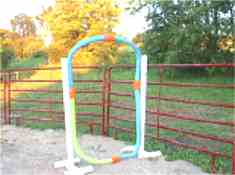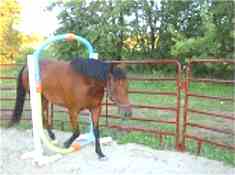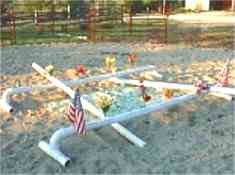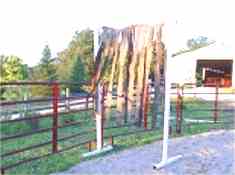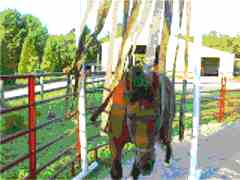Obstacle Courses Made Easy
|
|
We received these great ideas from Sharon Beck who built and uses these obstacles.
Obstacle Courses are a fun way to expose your horses to unusual situations and desensitize them to the real world. I've seen pictures of obstacle courses in magazines, but they all were massively built with timbers, railroad ties and the like. Being an over 40 women with very little building skills I needed some material that was easy to work with and that could be moved around easily by one person. As luck would have it, I started training my dog in agility. Seeing all the nice agility obstacles built out of PVC pipe, I decided to try and build a few horse obstacles with PVC. I was pleasantly surprised to find out how easy it was. PVC is lightweight but strong, there are all sorts of angles and joints premolded to work with. You don't need to nail or screw the pieces together, you just slide the adjoining ends together and glue. It doesn't need painting, won't rot in the rain and can take a licking and keep on ticking. Attached are pictures of the obstacles I was able to make myself. The horse shown in the pictures is my 5 yr old thoroughbred/holstener cross gelding. We started learning the Parelli methods this winter at Miller's barn in Kenosha Wis. They have weekly study group and John Harmes gives a clinic there once a month. The Hula Loop
Learning Skills:
Dealing with having things above and below him at the same time Passing through a opening
The Garden Walk
Learning skills:
Dealing with moving obstacles close by (flags) Stepping over poles on to a plastic tarp Strange looking objects (flowers)
The Streamer Door
Learning Skills:
Walking into moving streamers Dealing with having streamers touch different parts of his body
Continue to Part TwoNote: When working around any obstacles, you need to pay careful attention to your situation, your horse, any distractions and what others nearby are doing (what impact they may have on you and what impact you may have on them). Some horses may react unpredictably and you need to be prepared to guide them through any situation... or get competent assistance if you are not sure how to do so!
Return to Building Yourself a Horse CoursePress "Back" to return to the page that brought you hereGo to Case Study SectionReturn to Training SectionReturn to Wild Horse MentorsReturn to KBR World of Wild Horses and BurrosGo To
|

